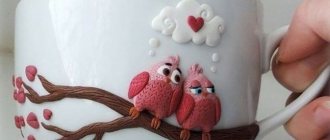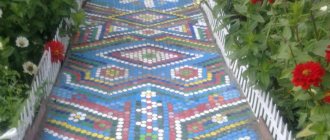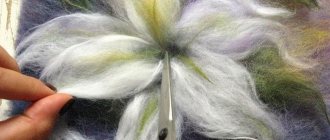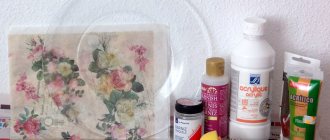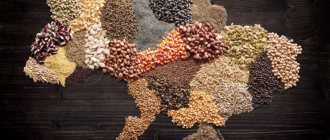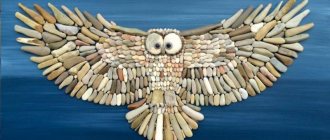Who invented cold porcelain?
The history of cold porcelain originates in ancient China. Masters of that time created works of art according to a recipe that Danes and Russian craftsmen later began to use.
Mention of the use of cold porcelain in Russia dates back to the beginning of the 19th century, when Pyotr Ulyanovich Ivanov, master of the imperial porcelain factory, began to produce the finest porcelain flowers using a special recipe to decorate perfume bottles, mirrors and vases intended for the emperor’s family.
Master class on cold porcelain
We offer the most successful option for beginners. For this we need the simplest components. This is corn starch (you can buy it at the grocery store), baking soda, glycerin (sold at the pharmacy), PVA glue (at the hardware store, regular stationery will not work), refined vegetable oil. Some craftsmen use baby oils, but for this cold porcelain recipe there is no particular need for it. We will also use rich hand cream for mixing.
Place four tablespoons of starch in a clean and dry bowl. Next, pour two tablespoons of vegetable oil. Add four to five drops of glycerin (about the size of a bottle cap). And add soda at the tip of a teaspoon. Now mix all the contents of the bowl. We try to make everything even. After this, add four tablespoons of PVA glue, which we pre-mixed. Mix again until smooth. First we do this with a spoon, then you can continue with your hands. Don’t be afraid to get your hands dirty, they can be washed off easily, and there are no caustic substances in our product.
The mass must be kneaded until it forms a thick dough, such as is used, for example, when making dumplings. If it turns out too liquid, you can add a little starch. If, on the contrary, it is a bit thick, then add a little PVA glue. After the mass begins to thicken, you can continue kneading it with your hands. This will be much more convenient. Add glue or starch as needed. In the end, you should have a dough-like mass that stretches like soft plasticine. Before you start sculpting, you need to lubricate it well with hand cream, wrap it in a plastic bag and let it rest at room temperature for two to three hours.
The products are hard, like plastic. They can be used in any decor.
What is good material for crafts?
Cold porcelain (crafts for beginners, step-by-step diagrams with descriptions are given later in the article) is a plastic mass with a smooth, uniform texture that hardens when it dries.
Ceramic products made from cold porcelain do not require heat treatment; they can be painted with varnish or paint.
To make the composition you need the most affordable materials that can be bought in any store. The modeling mass has the best ratio between the price of ingredients and the quality of the resulting crafts.
Plastic porcelain is completely non-toxic and safe for children's creativity.
Working with it does not require special knowledge and skills. The art of making porcelain products is learned experimentally from simple to complex.
What to sculpt?
Start with the easiest one, especially if you haven't sculpted at all before. Knowledgeable needlewomen believe that the simplest thing in modeling is flowers. It’s not difficult to sculpt them, and as the process progresses, everyone will understand all the subtleties of working with porcelain. Below you can see detailed step-by-step instructions for making flowers from cold porcelain.
Related article: Crochet top for girls: master class with diagrams and description
Bouquet of lilies of the valley.
Blooming bud.
Naturalistic iris petal.
White bud.
If you have experience in sculpting, try making a toy. This will be a little difficult for beginner crafters, so get started with the figures after some practice.
Bear.
Giraffe.
Puppy.
These are quite easy DIY master classes on cold porcelain crafts.
What is rarely sculpted from cold porcelain are fruits, vegetables and berries. Firstly, such a dense product will take a very long time to dry. Secondly, this material does not become stone, it retains a slight softness, so such rounded figures are quite easily deformed. The product loses its attractive appearance and can be safely thrown away.
If you plan to use such products as decorations (that is, they will simply lie in some place), then you can mold them, since the chance of damage to the figure is significantly reduced.
What can you mold?
Porcelain crafts are distinguished by their beauty and grace. Plastic mass can be used in various fields.
The most popular products made using the modeling technique are:
- costume jewelry (pendants, earrings, bracelets);
- hair decorations (hairpins, elastic bands with decor, headbands);
- interior items (decorative flowerpots, boxes, vases, lamps);
- cartoon characters, figures of animals, insects, people;
- gift souvenirs;
- decorative decorations for vases, mugs, flower pots and wall panels;
Recipe for making a mass for sculpting flowers with flexible petals
Two "secret" ingredients for this recipe:
- stearin (grated, I scraped the candle with a knife), about a teaspoon,
- and filler from a disposable diaper - cellulose - in the size of a tablespoon; from a diaper with gel will not work.
Materials:
- premium corn starch,
- glycerol,
- Vaseline oil,
- PVA construction adhesive (contains plasticizer),
- stearin,
- cellulose.
We repeat all steps as in the first recipe, mix the liquid ingredients, add stearin (not paraffin!), cellulose, stir thoroughly and heat.
The first recipe for the mass can be used without a microwave, but only for small products. Instead of using a microwave, they suggest cooking in a water bath on a non-stick surface. I haven’t tried it because I have a microwave. If you use it at home, wash it as usual after preparing the mixture and do not use the container for food, these precautions are not unnecessary.
The mass is stored at room temperature, storage time is about a month. Citric acid as a preservative. I haven’t cooked a large quantity, but I cook two masses, with and without cellulose. From time to time I take it out and knead it, “revive” the mass, and put it back into the bag and container. If the mass for sculpting flowers is a bit soft, add a little of the first mass before sculpting and mix.
There are also secrets , or rather some things that can sometimes help:
- If the mass is a little liquid, “creeps”, has lain down and is not what it should be, you can save the situation with a drop of sodium tetraborate (borax with glycerin), but only a drop and mix thoroughly, do not add to the whole mass, try it so as not to spoil it, otherwise the mass will turn into a lump and be thrown away.
- If the mass is a little tight, you can try to save it by mixing in castor oil, lubricate your hands and knead.
Master class for beginners on making the mass with your own hands
Cold porcelain (it is recommended to make crafts for beginners from a simple mixture without heat treatment) has several variations of recipes. They differ in ingredients and method of preparation.
Recipes without heat treatment
Recipes for preparing modeling mass are divided into 2 types: with and without heat treatment.
At the same time, the finished mixture does not differ in consistency and quality.
To prepare the mass classically, you will need to do the following:
- Mix 4 tbsp. l. any starch with 2 tbsp. l. vegetable oil and add 5 drops of glycerin.
- Pour a little soda into this mixture (at the tip of a teaspoon) and 4 tbsp. l. PVA glue.
- Mix the mixture very thoroughly. You can stir with a spoon first. When the mass thickens, begin to knead it with your hands.
- Before modeling, roll the “dough” into a ball, grease it with rich cream and put it in a plastic bag for 3-4 hours.
Recipes with heat treatment
Heat treatment when creating a plastic mass involves the use of heat on a stove or in a microwave oven.
The simplest and most accessible recipe consists of only 3 components:
- baking soda - 1 part;
- starch - 1 part;
- water - 1 part.
Cooking method:
- The listed ingredients should be poured into a frying pan with high edges and mixed thoroughly.
- Then, start heating the mixture over low heat, stirring constantly.
- When a lump forms, you need to thoroughly knead it with your hands for 2-3 minutes.
The resulting composition has a homogeneous dense consistency. The mass turns out to be plastic, but not stretchy. It is well suited for sculpting figures.
The other option is more complex, but products made from this mass are elastic even when dried.
Required ingredients:
- starch;
- PVA glue;
- baby skin care oil;
- lemon juice (wine vinegar);
- oily skin cream.
To make cold porcelain you need to do the following:
- Mix the ingredients in the following quantities: 1 tbsp. starch and PVA glue, 2 tbsp. baby oil and lemon juice.
- Place the mixture in the microwave for 25 seconds. and mix well again.
- Repeat heating 2 more times.
- Next, knead the mixture for at least 5 minutes. using your hands.
- Treat the resulting mass with rich cream, wrap it in plastic and put it in the refrigerator.
- Use cold porcelain no earlier than after 3 hours.
How to whiten plastic porcelain?
The whiteness of porcelain directly depends on the color of the ingredients.
If the mass turns out yellow or beige, it can be bleached using the following method:
- Knead the mixture according to the classic recipe with cooking in the microwave (2 tablespoons each of starch and PVA glue, 1 teaspoon each of glycerin and lemon juice, 1/4 teaspoon each of paraffin, Vaseline and baby body oil).
- Add 1 tsp to the ingredients. oxygen laundry bleach powder or a spoonful of liquid product.
- Cover the mixture with polyethylene and leave for 2-3 hours to bleach.
- Cook the mixture in short intervals (5-6 seconds each) with constant stirring until the mixture thickens.
How to correct cooking errors?
If it happens that during cooking the mass overheats and becomes crumbly, or vice versa, the porcelain is not dense enough, you can use the following recommendations:
- If, when preparing a classic recipe, the dough turns out to be very liquid, you need to add a little starch.
- Many masters categorically advise against diluting the mixture with water. If the mass is crumbly, it is recommended to add PVA glue.
- To ensure that the modeling mass is plastic and retains its elasticity even after drying, paraffin should be added to the composition.
Coloring
Cold porcelain (crafts for beginners do not require special skills to make) can be either colorless or colored. Depending on the type of product and the intensity of the color of the craft, various painting techniques are used.
You can mix the pigment directly into the plastic mass, or you can paint the finished product after drying.
The table shows the main methods of tinting the modeling mass:
| Application method | Dyes |
| Surface tinting of the finished product |
|
| Coloring the modeling mass (mixing pigment into a plastic composition) |
|
Drying finished products
Compliance with drying rules is the key to success and obtaining a beautiful product. Depending on the size and thickness of the craft, different drying times may be required.
Do not forget that some elements are quite thin (flower petals, leaves) and in order to maintain their shape they must be placed on the base at a certain angle and with the desired bend. Thus, it is convenient to dry rose buds in the cells of egg trays, and to give graceful curves to the leaves and petals, they can be laid out on the spread of a book, previously covered with foil.
The average drying time for cold porcelain crafts is 24 hours at room temperature. At the same time, for uniform drying, the products must be turned over.
To speed up the drying process, you can use the following method: heat the oven, turn it off and place porcelain crafts inside.
How to make cold porcelain with your own hands?
To do this, you need to acquire the following materials:
- 200 grams of PVA glue;
- Rice starch (if you don’t have it, you can use corn starch) in the amount of 1 cup;
- 2 tbsp. spoons of glycerin;
- Any non-greasy cream.
The ingredients need to be mixed and set aside for 10-20 minutes. The mixture should not be left for a long time; work should begin immediately and, if possible, use all the material. Sometimes citric acid is added to the composition to increase the shelf life of the product.
If you add water, the products will become fragile. To color porcelain, use any food coloring or chalk. It is recommended to refine the surface no earlier than 2 days after the product has dried.
Modeling tools
For modeling, you need to prepare a workplace with good lighting, cover it with film or a special mat for creativity. It should be taken into account that the modeling compound absorbs any dirt very well, so the work must be done with clean hands. If necessary, it is recommended to periodically wipe your hands with wet wipes.
To work with cold porcelain, you will need special tools, as well as auxiliary materials:
- Rolling pin for rolling out large layers of porcelain;
- Stacks of different shapes for rolling, cutting, creating corrugated edges, holes and textures on the surface of workpieces.
- Scissors (large and small).
- Tweezers with different tips.
- Wire cutters.
- Wire for creating flower stems and other structures.
- PVA glue for assembling products.
- Dyes for tinting the mass.
Beautiful crafts made from cold porcelain. Step-by-step description of the sculpting process
Cold porcelain has an undoubted advantage: when it dries, it becomes hard. Therefore, even children and novice craftsmen can make crafts that will serve as original gifts for friends and family.
Flowers
A simple master class on making spring crocuses will appeal to both beginners and experienced craftsmen.
To work, you need to prepare a mass for modeling and paint it in 3 colors: purple, yellow and green. You will also need forms for cutting out petals (you can make your own from a tin can) and wire for making stems.
To create flowers you need:
- Roll out the porcelain mixture on a flat surface into a layer 2 mm thick.
- Using a mold, cut out the petals (you will need to make 6 petals for each flower).
- To give the petals a pattern, you need to press them against a textured surface or special molds.
- Place the molded petals on plastic spoons to dry.
- Make stamens and pistils from the yellow mass. For pestles, cut a thin layer into small triangles. Cut one edge of the triangle with thin scissors and then twist it into a tube. For each flower, make 3 pistils and 3 stamens.
- Wrap the wire for the stems with electrical tape. Attach all the elements of the flower to the stem (pistils and stamens in the center, petals in 2 rows around).
- Make the stems and receptacle from green porcelain.
- To dry, hang the flowers with the buds down.
- Make long leaves from a green plastic mass.
- Place the finished flowers in a vase or collect them in a bouquet.
You can make other flowers in the same way. The difference lies in the shape, size and number of petals.
Cold porcelain crafts are available for beginners
Lush lilac inflorescences made from lilac porcelain look very natural. To create them you will need scissors, tweezers and wire.
To make a flower, you need to roll a small ball, form a shape in the form of a drop and use scissors to cut the thick part into 4 segments. You can shape the petals using tweezers. To create unopened buds, a drop from the mass only needs to be lightly pressed with the blades of scissors.
Flowers need to be collected on a ready-made base by putting each flower on a wire.
Bijouterie
Cold porcelain (crafts for beginners may have simpler patterns) is a very plastic material that can be modeled. You can combine any colors in your creativity, which is suitable for creating bright jewelry.
A bracelet with pink pearls and small peach blossoms will look incredibly delicate. To make it you will need to make about 30 flowers from porcelain. The basis for the bracelet can be any old bracelet with a chain base.
Assembly order:
- On the pin you need to sequentially put a pink mother-of-pearl bead and a porcelain flower.
- Using pliers, bend the free edge of the pin into a ring.
- Make similar pendants without flowers from beads of different sizes.
- Assemble the bracelet, alternately attaching pendants with flowers and beads to the chain.
A pendant and earrings made in the same style from small rose buds surrounded by delicate greenery will complement an elegant look or serve as a gift for a significant event.
A voluminous ring in the shape of a lush peony can become a bright accent for an evening look.
To create it, you need to buy a ready-made base for the ring and make a flower from cold porcelain according to the following description:
- For the base, you need to put a small ball made of plastic mass on a toothpick.
- Next, you need to make the petals and sequentially attach them with glue to the central ball.
- The petals are made from small pieces of cold porcelain. First you need to roll the ball, then use a stack to roll it out on your palm.
- Without peeling the petal from your palm, make small notches along the outer edges with a stack and lightly roll it out again.
- Place the petal on your index finger and use a stack with a ball at the end to give it a curved shape.
- The petals need to be strengthened sequentially in a circle, each time increasing their size.
- The flower must be dried and then glued to the blank for the ring.
Basketry
For a spring bouquet, you can make a wicker basket. This is a simple craft suitable for beginners.
To make this craft you will need to take the “dough” of the desired color. You can make a brown basket, or you can make an unusual pink or blue one. The manufacturing scheme boils down to weaving a basket from strands rolled up into a plastic mass.
Assembly sequence:
- For the base, you can take a small glass jar or other container.
- 13 pieces of strands with a diameter of about 2-3 mm need to be laid out in a circle and their ends glued together in the center of the bottom of the jar.
- Glue a circle of cold porcelain in the middle, which will serve as the bottom of the basket.
- After drying, remove the workpiece from the base and braid the rods in a circle.
- The top of the basket around the circumference can be closed with two rods twisted together.
- It is recommended to make the handle from wire wrapped with plastic tape.
Figures
Both children and adults will enjoy sculpting figures from plastic mass. Making them is no different from modeling them from plasticine, but the result will please you in that they can then be used as toys.
In the same style you can make various interior and garden figures, souvenirs, key rings and children's toys. Figures made from plastic dough can be either simple or very complex, with many elements that can be equated to works of art.
Various materials can be used to decorate cold porcelain products. This can include beads, beads, glass crystals, textile and metal elements.
New Year's crafts
The most popular type of New Year's crafts are Christmas tree decorations. Making them from cold porcelain mass is very simple. To do this, you need to cut out figures from a layer of rolled out mass, make holes for hanging, dry and paint.
To create New Year's figures you need to use your imagination. The easiest way is to buy ready-made molds and cut out blanks using them. You can also use improvised means to create themed decorations.
So, simple balls with snowflakes can be cut out using a simple glass, and an openwork pattern can be made using a knitted or plastic napkin, which must first be pressed onto the dough layer using a rolling pin. Holes for ties can be easily made using cocktail straws. After drying, the relief pattern can be tinted with silver or gold paint.
To make decorations in the form of Christmas trees, just use a knife to cut triangles from the rolled out mass, use a fork to make something like pine needles and paint the toys green.
A snowman can be made from 2 circles of different diameters, glued to each other with a slight overlap. The junction of the circles should be covered with a scarf, which is made of a bright-colored strip with fringe along the edges. A fringe-like appearance is created by making cuts with a knife or scissors. The nose, eyes and mouth are also made from a mass of different colors.
Bright jewelry
Cold porcelain can be used to make wonderful and unique jewelry. The principle is as follows: various parts are made, and after drying with PVA glue they are attached to the fittings. Let's say you want to make earrings from flowers. Blind them, place them on some oblong object (for example, a needle) and leave the flowers to dry. After the elements are ready, pull out the needle - you will get a hole through which you can pull the thread or fishing line. They make excellent parts for making jewelry.
Photos of cold porcelain jewelry:
For decoration you can use various materials - beads, beads, crystals, pendants, shells. Their combination looks very beautiful and elegant.
The most interesting thing about cold porcelain is that you can make it yourself. But this is not a very easy process, and before you try to do it, it’s better to practice sculpting with a store-bought one - what if you don’t like working with porcelain? In addition, it is difficult for beginners to make high-quality material on the first try, and if the cold porcelain does not turn out very good, you may be disappointed in the ceramics and not understand that with properly prepared cold porcelain, a completely different process of work occurs.
Related article: Master class on a do-it-yourself cardboard box: making from a pattern
This modeling mass is prepared from starch (corn or rice gives the mass a white color, potato serite material), PVA glue, glycerin, cream and citric acid. Starch and glue create the porcelain itself, while PVA gives it the property of self-hardening in the open air. There are several cooking methods - with cooking, without cooking and in the microwave. Such porcelain is stored in tight packaging, with minimal air penetration, from 3 weeks to six months. This is a very rough recipe that every needlewoman tries to improve on her own. If you enjoy working with cold porcelain, then try to prepare it yourself in the future - this is a fun process that will save you money. In addition, by experimenting, you can come up with your own recipe for ideal cold porcelain.
Decoration of dishes
Porcelain mass is unstable to temperature changes, so it is not used for making dishes. But a decorative mug decorated with a floral arrangement can become an enviable piece of kitchen furniture.
To create a designer cup you will need:
- Bright rose buds, forget-me-nots, leaves made from mass.
- The base is made of green porcelain, on which the composition will be attached.
- Glue (for strength, you can use E6000 glue).
The order of assembly of elements consists of the following steps:
- On the cup you need to stick a base in the form of a green porcelain stain.
- Large flowers should be strengthened in the center.
- The perimeter of the spot must be filled with green foliage.
- Between large inflorescences, you need to strengthen smaller flowers and unopened buds.
- The upper part of the composition can be decorated with a bouquet of blue forget-me-nots with a bright yellow center.
As a gift, you can give a tea set decorated with scarlet poppies and bright greenery. Fans of feasts will appreciate salt shakers, sugar bowls and other kitchen utensils decorated with floral arrangements.
Bright tulips of their cold porcelain
Required tools and materials:
- gouache;
- scissors;
- glue;
- toothpicks;
- baby cream;
- rolling pin;
- brushes;
- wire;
- HF.
Here is a simple step-by-step modeling for beginners. It is simple and does not require large material and energy costs.
Modeling flowers from cold porcelain consists of the following steps:
- Treat your tools, table surface and hands with cream.
- To make the center of a tulip, you need to paint the material in a pale light green shade.
- The pistil of a tulip consists of 3 divisions, and the number of stamens is 6.
- Bend the tip of the wire into a loop, dip it in glue and attach a pestle to its end. Make three grooves in it with a toothpick, thus dividing it into three equal parts.
- Make 6 more cuts in the middle so that the legs of the stamens are formed.
- Let's move on to making the stigma of the pistil. Attach it to the top and use a toothpick to shape it into the desired shape.
- Mix yellow and red gouache in a drop of water. You will get an orange tone, color the anthers.
- Make the flower itself pink.
- Roll out the blanks into petals, helping yourself with your hands or the rounded tip of a rolling pin.
- Use a toothpick to draw a petal pattern. Leave to dry for about 3-4 hours.
- After the petals have almost dried and taken the desired shape, you need to attach the tip of the petal to the Kinder Surprise box and lightly wrap it with a wool thread.
- Assemble the bud by strengthening 2 rows of 3 petals.
- Place light green HF tape between the rows and cover everything with glue.
- Leave the buds to dry for about a day, heads down.
- After drying, continue working.
- Color the material for the leaves and stems.
- Cover the leaves and stems and leave for another 12 hours.
- Roll out the HF sheet and cut out the leaves using scissors. Make the edges thin by rolling them out with a regular rolling pin.
- Leave to dry for a day, making a curve in the center of each.
- Get to tinting. Mix white and red gouache with water.
- Tint the entire product with this color.
Apply a light green tone to the bases of the petals so that there are no sharp transitions.
Attach the leaf to the stem, and the bright tulip is ready.
Decoration of photo frames
A photo frame has always been an appropriate gift for any occasion. A stylish craft made with your own hands can become an independent element of a designer interior or simply serve as an item for storing family memories.
Photo frame design options:
- Photo frame in a nautical style, decorated with shells and starfish, made in white and blue tones.
- Children's photo frame with cute figures of cartoon characters and baby items (baby bottles, pacifiers, rattles).
- A stylish interior accessory with large inflorescences of roses, peonies, lilies and hydrangeas.
The availability of ingredients and ease of manufacture makes cold porcelain mass a leader in the arts and crafts. Modeling methods are available to children and craftsmen just starting their creative activity.
Author: Maria Andryukova
